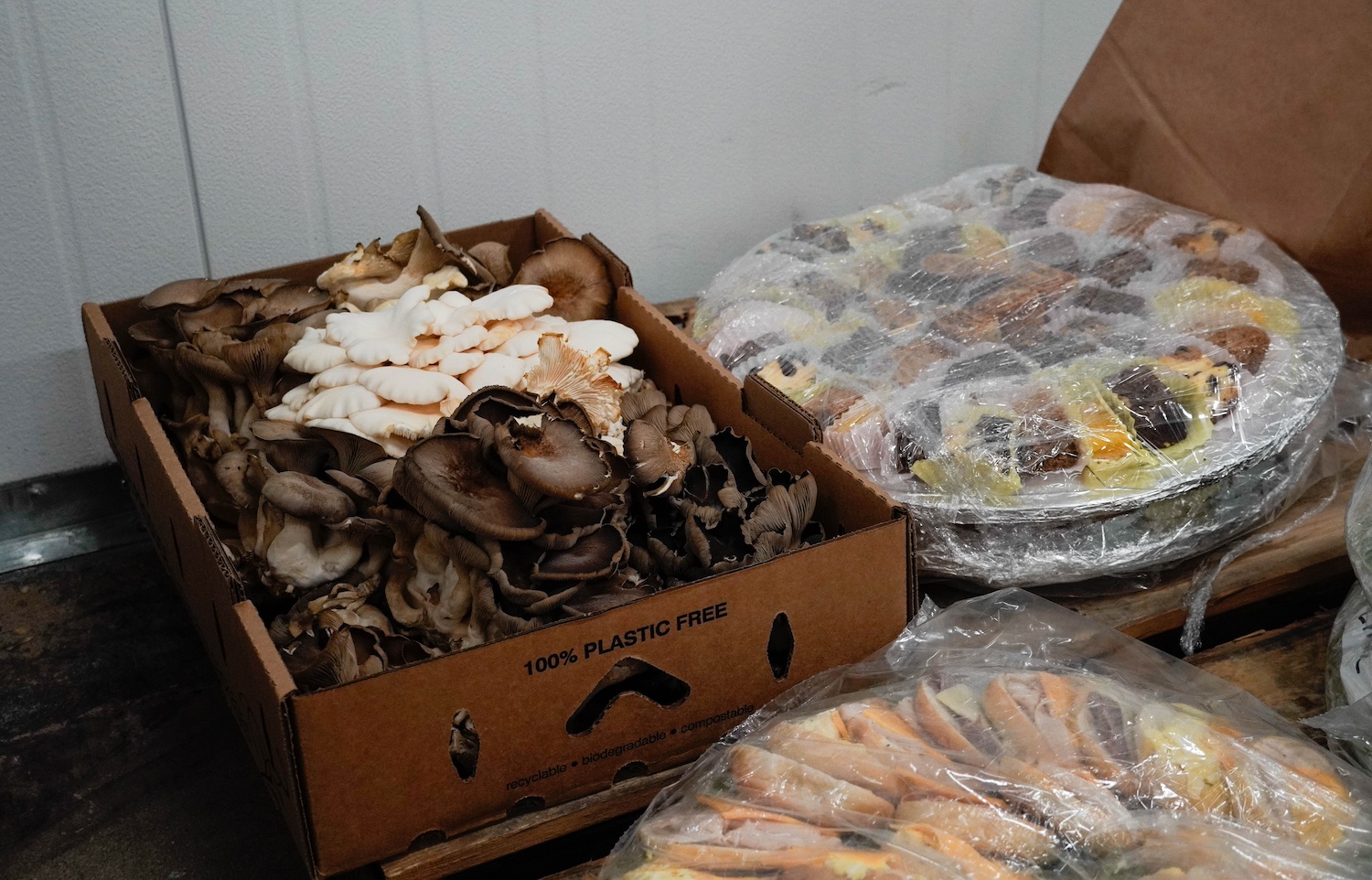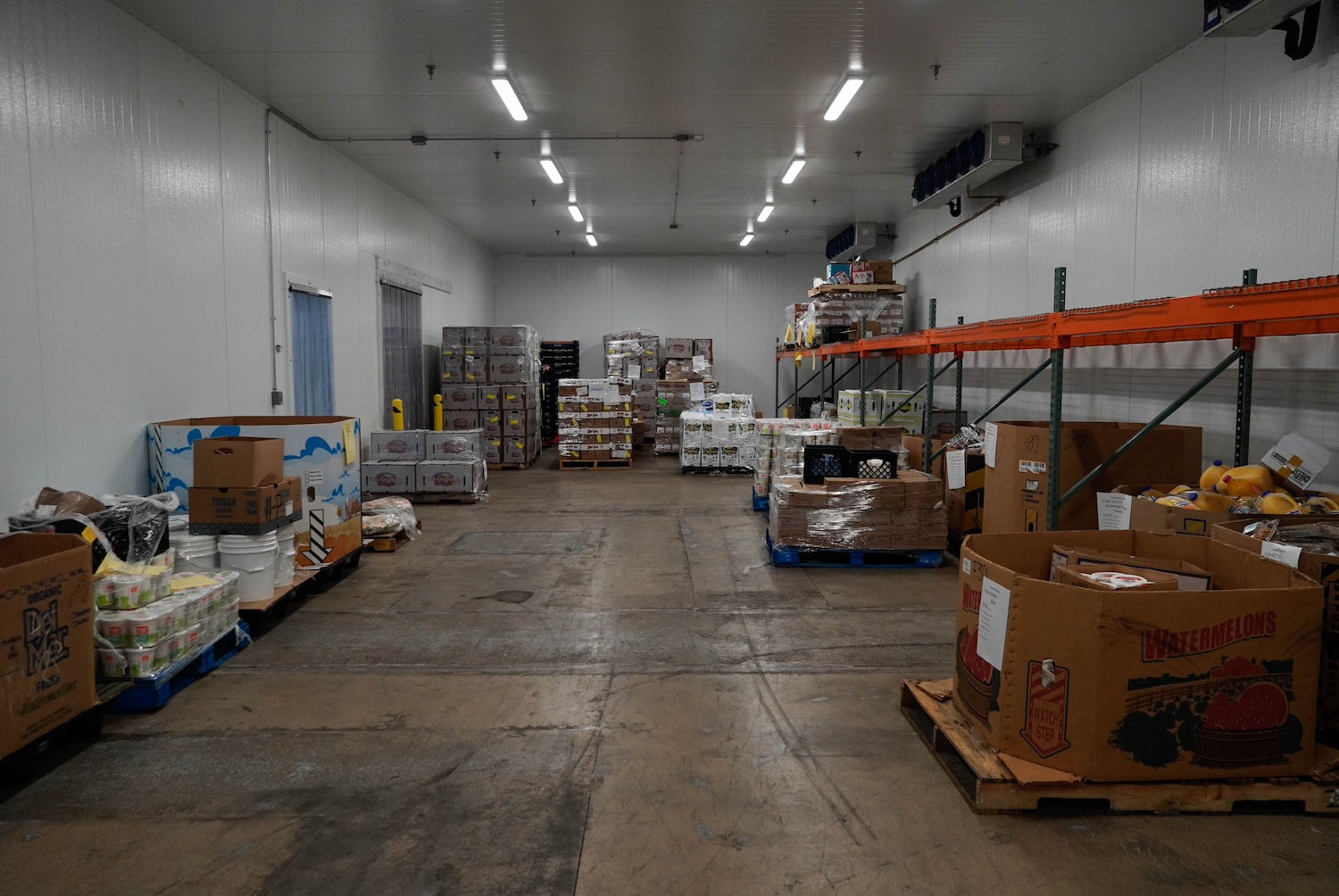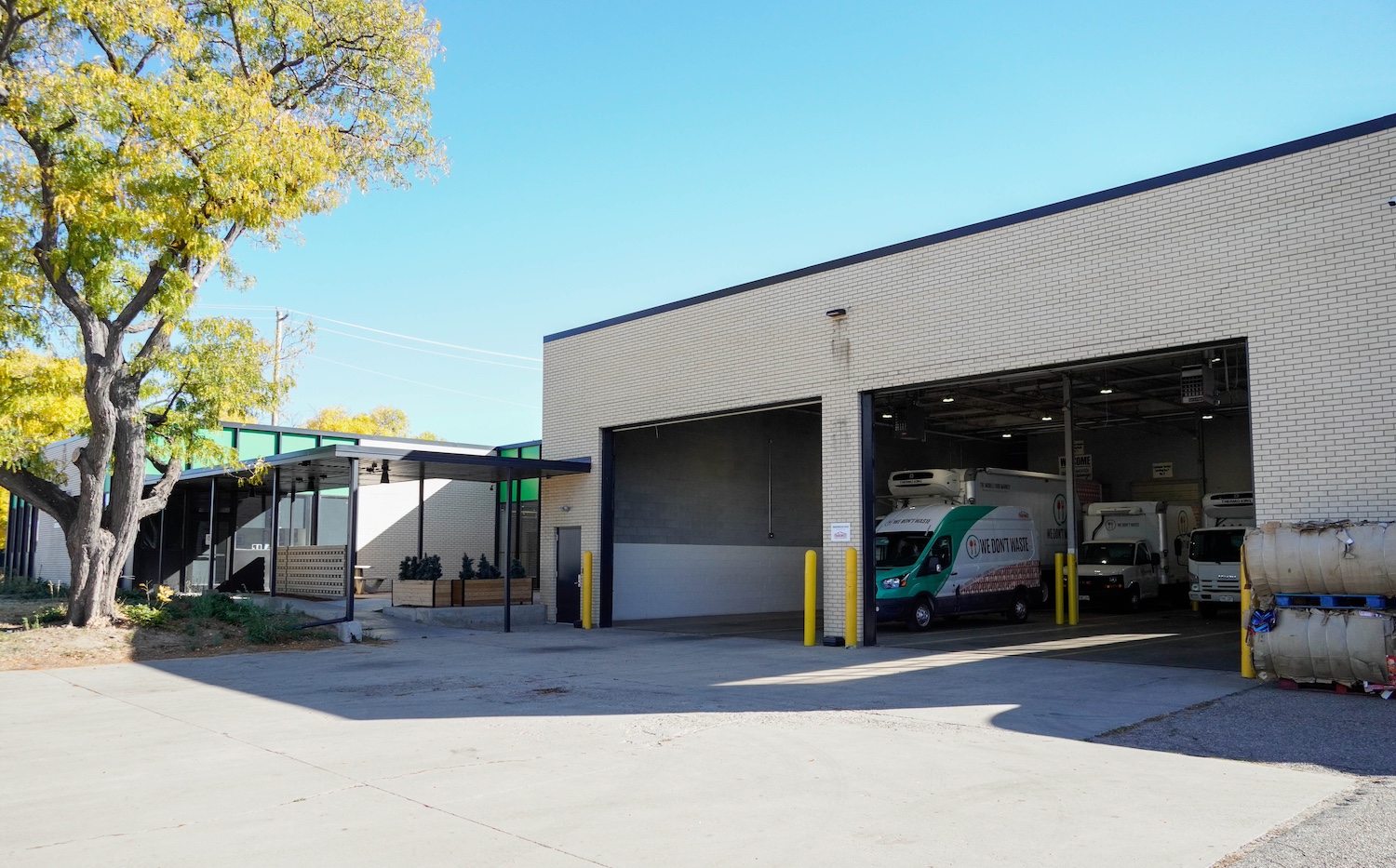
Some of the vehicles in the fleet We Don't Waste uses to pick up and deliver food donations. (Image: Taylor Haelterman)
This story is part of The Solutions Effect, a monthly newsletter covering the best of solutions journalism in the sustainability and social impact space. If you aren't already getting this newsletter, you can sign up here.
When Arlan Preblud noticed the abundance of food going to waste in Denver, he stepped away from a 30-year career in the local legal and business scene to drive around the city, pick up as much excess food as his Volvo could carry, and deliver it to local food banks.
That was in 2009. Preblud’s ambition has since evolved into a full-fledged nonprofit with a fleet of refrigerated trucks, a dedicated team of staff and volunteers, and a 30,000-square-foot facility. We Don’t Waste serves more than 100 hunger relief organizations across Denver, saving and redistributing 220 million servings of food to date.
Just under 40 percent of the total food produced in the United States last year went to waste, totaling over 91 million tons, according to the food waste prevention nonprofit ReFed. Surplus food donations saved just 1.75 million tons from that fate. But that small amount can have a big impact, especially when it’s used to address food insecurity.
One in nine people in Colorado are facing hunger, according to Feeding America. And that number seems to be on the rise.
The percentage of Coloradans experiencing food insecurity increased three points from 2021 to 2023, according to a Colorado Health Institute survey. Over 11 percent of people said they ate less than they should at some point in the last year because they couldn’t afford food. Denver County showed above-average rates of food insecurity for the state.
We Don’t Waste recovered almost 23 million servings of food in 2023, according to its annual report. The nonprofit estimates diverting that food from the landfill prevented over 10 million pounds of greenhouse gas emissions and prevented wasting the almost 506 million gallons of water used to produce it.
“What's cool about what we do, on the food waste side especially, is it doesn't just impact Denver,” said Kyle Endres, executive director of We Don’t Waste. “It impacts the whole planet because you have fewer greenhouse gas emissions and the impact on climate change that results from that. It's this cool local solution to this worldwide problem.”
The organization receives donations of perfectly edible, surplus food and drinks from every part of the food system. Team members might pick up food that hasn’t sold at a bakery, excess produce at a farm or leftovers at a convention center after an event. At the same time, a production center or supermarket could drop off whole pallets of food that’s short-dated or has misprinted labels. A typical tour of the warehouse might include massive boxes of bananas and crates of milk alongside whole wheels of fancy cheese and a small box of obscure mushrooms.

Tax benefits, reduced environmental impact and fewer trash disposal fees are all benefits businesses might see from donating excess food. But many of them just don’t want to see the fruits of their labor thrown away, Endres said. And it’s important to them that they can provide something that directly benefits their community.
“We're helping solve a problem for our food donors,” he said. “They don't want to waste the food that they can't sell for whatever reason, and we meet that need. They don't have to pay for additional waste management. They don't have to feel bad that they're throwing away perfectly good food. We provide them a mechanism to get it out to the community.”
This year, volunteers also started rescuing and delivering small food donations that aren’t feasible to pick up with the organization’s box trucks. Using an app, they can collect a donation listed by local businesses and drop it off at a nonprofit or the warehouse. In the first four months of 2024, volunteers completed 219 food rescues this way.
Some of those deliveries go to the Heart and Hand Center’s community fridge in Denver’s Five Points neighborhood. The center provides daily afterschool programming for youth, which includes meals, and support for the whole family. Its community fridge typically sees over 50 people every day.
“We regularly hear from folks who share that our food programs have been instrumental in allowing them to stay housed because they don't have to choose between paying rent and paying for food when they can supplement their pantry through the nutritious and delicious offerings that We Don’t Waste contributes to the community fridge,” Angie Neslin, the organization’s resource center program manager, told TriplePundit in an email.
The center also works with We Don’t Waste to stock its no-cost grocery program, which serves 50 to 100 families weekly, and host an annual summer barbecue. Altogether, the center distributed over 140,000 servings of food from We Don’t Waste this year, Neslin said.
When Preblud started this journey in his Volvo, he aimed to be a better matchmaker. The nonprofits where he volunteered often received food that wasn’t up to the quality they wanted or didn’t match their needs, Endres said. Preblud wanted to fill that gap as best he could by tailoring which food donations went where. That’s still at the heart of what We Don’t Waste does today.
“We want to be in partnership with the nonprofits that we work with because if we didn't have them, it would be a lot harder to find a home for all the food that we rescue,” Endres said.
Nonprofit partners range from food pantries and soup kitchens to shelters that serve meals to schools, daycare centers and afterschool programs. Each serves a unique community, but all have food programs focused on addressing food insecurity and improving health outcomes.
The food supply is entirely based on donations, so the level of customization can only go as far as what is available, Endres said. The team can’t control exactly what comes in, but by asking for frequent feedback, they can customize as much as possible, including delivery frequency and whether the nonprofit picks up the food or receives deliveries.
“We really try as best we can to match food with nonprofits in a way that they can use it,” Endres said. “Taking into account what is their storage like? Do they have cold storage? How many people are they serving? How often are they open? And what dietary preferences do their clients have? We don't want to be bringing food that doesn't match a certain demographic population because then they'll just waste it.”
BeyondHome, a transitional housing facility for families facing poverty and homelessness, started receiving food from We Don’t Waste during the COVID-19 pandemic. It serves about 50 adults and 80 children across its 37 apartments, said Allison Bristow, BeyondHome’s director of finance and human resources.
Bristow also runs the housing nonprofit’s food bank, which is open to residents twice a week to pick out whatever they’d like. Donations supplement what she can purchase with a monthly budget of $500, often used for necessities like toilet paper, eggs and milk.
Once a week, Bristow stops by the We Don’t Waste warehouse to shop the shelves. It’s a huge financial relief for BeyondHome, likely saving thousands of dollars a year, she said.
Most of the time, she’s picking up stuff that many families at BeyondHome wouldn’t be able to afford themselves, like meats, specialty cheese, and fun extra items like popsicles and frozen waffles. Alongside the relief of not having to worry about affording food, being able to try new things has a huge positive impact on families.
Bristow remembers the first time a family that recently moved in stopped by the food bank. “I was in tears because the kids were like, ‘Can we have that piece of cake?’ ... ‘Can we eat it now?’” she said. “And they were so amazed at everything that was available for them to take.”

We Don’t Waste also distributed food for free at 89 farmers’ markets last year. Year-round, team members and volunteers bring these markets to Denver neighborhoods where food access has been historically, presently and intentionally neglected. Known as food apartheids, residents of these communities have limited access to fresh, affordable, nutrient-dense foods. Roughly 50 food apartheids, also called food deserts, exist in the Denver Metro area.
“I really see the impact when I go to our mobile markets or talk to one of our partner nonprofits,” Endres said. “There's just so much need in the community. And we're not going to be able to give all the food that a family needs at a mobile market or all the food that a nonprofit needs to serve their clients. But it just allows everyone to have access to different types of food and more food.”
Even with the colossal amount of food We Don’t Waste rescues, there’s still a waiting list of about 45 nonprofits that would like to receive food. The organization is always looking for more donors to try and meet the need.
It also faces staffing and volunteer challenges, particularly with the growth in popularity of the farmers’ markets.
“We're thankful to have a very committed volunteer base, and we've got some volunteers that come every week, and they're basically like additional staff,” Endres said. “But our markets have grown such that we need 20 volunteers for each market. That puts a strain on our staff to find the volunteers and train them and make sure they're ready.”

But there are no plans to slow down. We Don’t Waste moved into its new facility at the end of 2023, and 30,000 square feet offer a lot of room to expand its community programs. As construction finishes on a demonstration kitchen and a classroom, the team is planning new ways to educate and connect people with food, Endres said. They hope to offer in-house food waste, gardening, nutrition, and cooking education and broaden the food accepted and distributed by preparing and upcycling foods — like making soup stock from vegetables close to perishing.
While We Don’t Waste is a homegrown solution, food waste and food insecurity are everywhere. Most major metropolitan areas have some kind of food rescue organization, and Endres thinks the We Don’t Waste model is replicable in areas that don’t. The team is always happy to exchange ideas with other groups looking to start a similar project in their city. Some have taken them up on that offer, visited the Denver facility, and brought what they learned back to their communities. Regardless of the approach, what matters is that good food isn’t going to waste, Endres said.
“Food justice is really important,” he said. “In a society where we have so much, people shouldn't be food insecure.”
Editor’s note: This story was created as a part of the Solution Journalism Network’s 2024 Climate Solutions Cohort, of which the author is a fellow.

Taylor’s work spans print, podcasts, photography and radio. She brings her passion for covering social and environmental issues through the lens of solutions journalism to her work as assistant editor.














